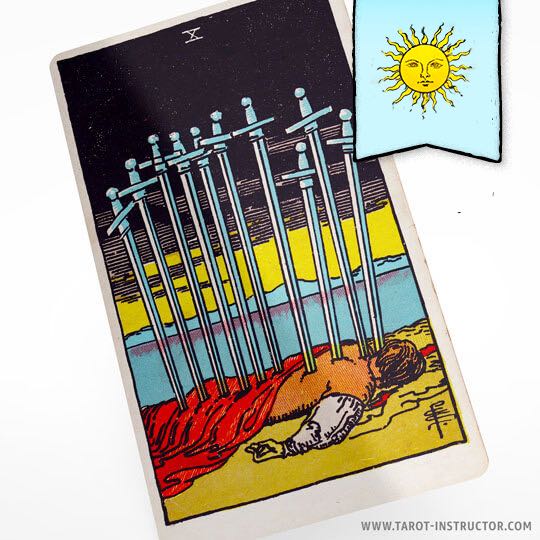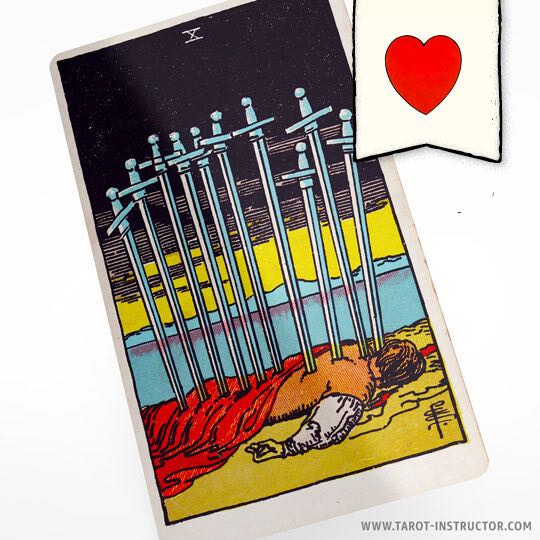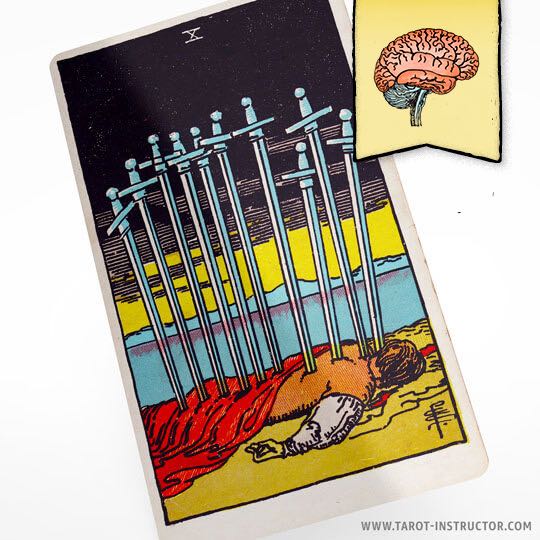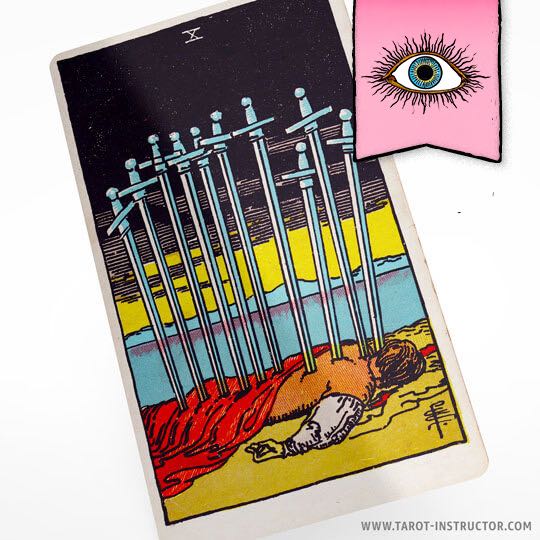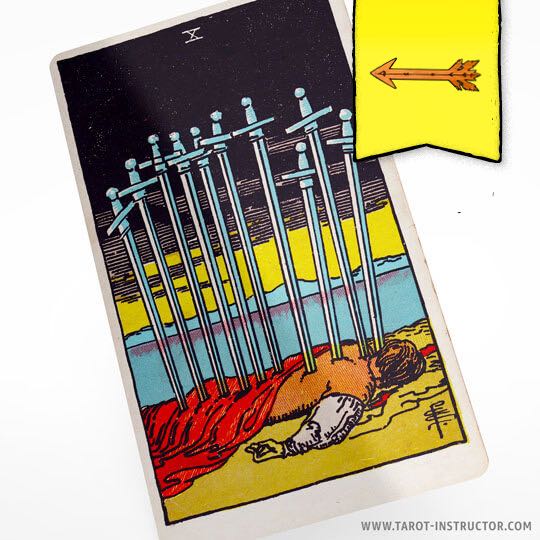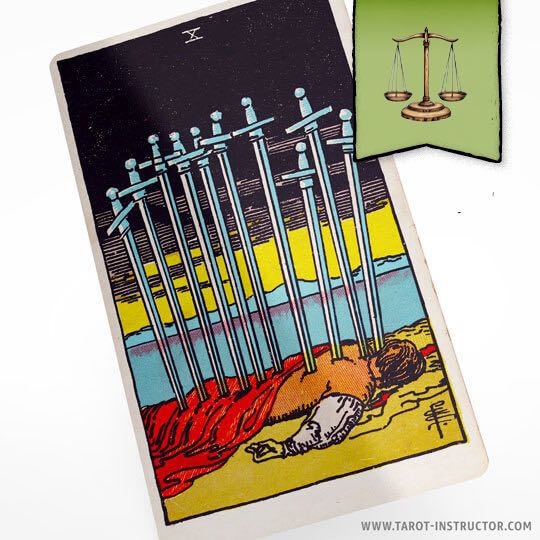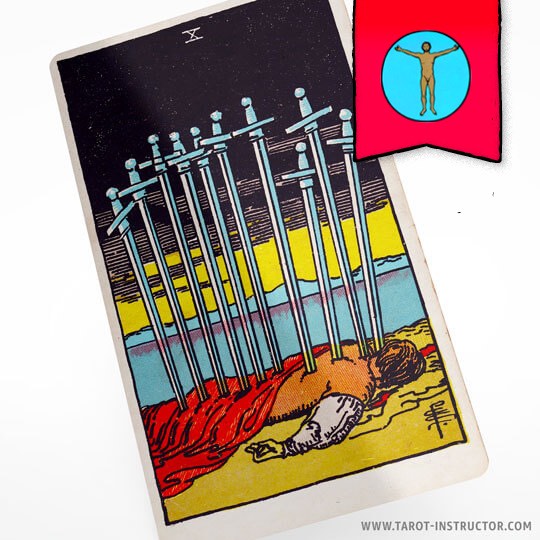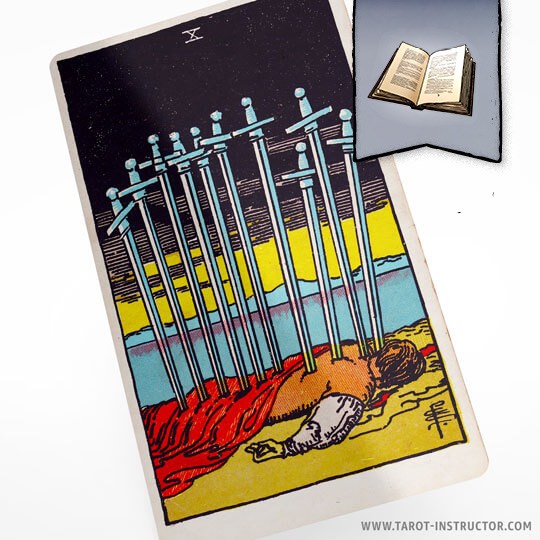Ten of Swords tarot card features following symbolic elements
Ten of Swords tarot card features following symbolic elements
Ten Swords: Feelings of betrayal lead to a painful ending, emphasizing the importance of seeking closure to heal and move on. The Figure: Helplessness in love calls for acceptance of the relationship’s end, fostering emotional healing and growth. The Sunrise: A new beginning emerges post-heartbreak, instilling hope for future love and the possibility of renewed joy. The Dark Sky: Current emotional turmoil highlights the necessity of confronting and processing pain, ultimately leading to personal growth. The Ground: The barren ground symbolizes the need for self-rebuilding, nurturing resilience, and preparing for healthier future relationships.
Table of content
- Ten of Swords keywords upright
- Ten of Swords keywords reversed
- Ten of Swords card element
- Ten of Swords zodiac sign
- The Symbolism of the Ten of Swords
- Ten of Swords as Present in Potential Relationships
- Ten of Swords as Present in New Relationships
- Ten of Swords as Present in Existing Relationships
- Ten of Swords as Present in Ex-Relationships
- Conclusion
Ten of Swords as advice
„Accept endings as a necessary step towards new beginnings.“
Ten of Swords keywords upright
Endings, Betrayal, Loss, Finality, Conclusion, Transformation.
Ten of Swords keywords reversed
Recovery, Rebirth, Renewal, Resilience, Survival, New Beginnings.
Ten of Swords card element
Air
Ten of Swords zodiac sign
Gemini
Understanding the Ten of Swords as Present (Upright and Reversed)
The Ten of Swords is a profound tarot card that embodies themes of endings, defeat, and transformation. This card is the 10th in the suit of Swords, which is associated with the element of Air and is primarily linked to the zodiac sign of Gemini. In this article, we will explore the meaning of the Ten of Swords as it pertains to the present moment, examining both its upright and reversed positions. We will also delve into its implications for potential, new, existing, and ex-relationships.
The Symbolism of the Ten of Swords
The Ten of Swords Card Number and Meaning
The Ten of Swords is the 10th card in the Tarot, and its number signifies completion and the end of a cycle. In numerology, the number 10 represents new beginnings that can arise from the ashes of what has concluded. The imagery of the Ten of Swords typically depicts a figure lying face down with ten swords in their back, symbolizing betrayal, loss, and the ultimate defeat. However, this card also signifies the potential for rebirth and renewal.
The Ten of Swords Element and Zodiac Sign
Belonging to the suit of Swords, the Ten of Swords is intrinsically connected to the element of Air. Air represents intellect, communication, and thoughts. The Ten of Swords is linked to the zodiac sign of Gemini, known for its duality, adaptability, and tendency to navigate complex situations. This connection emphasizes the importance of mental clarity and communication in overcoming challenges.
General Meaning of the Ten of Swords in the Present
When interpreting the Ten of Swords as present, whether upright or reversed, it is crucial to acknowledge the card’s themes of endings and transformation. In an upright position, the Ten of Swords signifies a moment of significant closure. This card indicates that you may be experiencing feelings of betrayal or loss, but it also suggests that this may be necessary for your growth. It encourages you to acknowledge the pain, learn from it, and prepare to rise anew from the experience.
Conversely, when the Ten of Swords appears reversed, it can indicate that you are in a state of denial about a painful situation. You may be avoiding necessary endings or struggling to let go of past hurts. The reversed Ten of Swords suggests it may be time to confront these feelings and release what is no longer serving you.
Ten of Swords as Present in Potential Relationships
Upright: In the context of potential relationships, the Ten of Swords as present upright signifies that you may be at a crossroads. While the card indicates endings, it also opens the door for new connections. You might encounter someone who understands your past struggles and offers a fresh perspective. This relationship could be transformative, helping you heal and grow from previous experiences.
Reversed: When reversed, the Ten of Swords as present may suggest that you could be clinging to past hurts, preventing you from fully engaging with new potential relationships. It may also indicate a tendency to repeat unhealthy patterns. This card serves as a reminder to be honest with yourself about your emotional state and to seek healing before pursuing new connections.
Ten of Swords as Present in New Relationships
Upright: In new relationships, the Ten of Swords as present upright signifies that both you and your partner may be navigating complicated feelings or past traumas. While this may initially feel like a burden, it can also serve as a catalyst for deep understanding and emotional intimacy. Embracing vulnerability can strengthen your bond and pave the way for a healthier dynamic.
Reversed: When the Ten of Swords as present appears reversed in a new relationship, it may indicate a struggle to let go of previous pain. One or both partners may be dealing with lingering baggage that hampers emotional closeness. It is essential to communicate openly about your feelings and work together to heal these wounds to foster a more robust connection.
Ten of Swords as Present in Existing Relationships
Upright: In the context of existing relationships, the Ten of Swords as present represents a pivotal moment for growth. You and your partner may be facing challenges that could lead to significant transformations within your relationship. While these moments may feel painful, they can ultimately strengthen your bond if addressed with honesty and empathy.
Reversed: When the Ten of Swords as present appears reversed in existing relationships, it may indicate unresolved issues that are festering beneath the surface. One partner might be avoiding difficult conversations, leading to feelings of resentment. It’s crucial to confront these issues head-on and engage in open dialogue to facilitate healing and understanding.
Ten of Swords as Present in Ex-Relationships
Upright: In the realm of ex-relationships, the Ten of Swords as present suggests that you may be processing feelings of grief or betrayal. This card encourages you to reflect on the lessons learned from past connections. Acknowledging the pain can help you move forward and make space for healthier relationships in the future.
Reversed: When considering ex-relationships, the reversed Ten of Swords may indicate that you are struggling to let go of past hurts. You may find yourself ruminating on what went wrong or feeling trapped in unresolved emotions. This card serves as a reminder to embrace closure and release any negativity that may be holding you back from personal growth.
Conclusion
The Ten of Swords is a powerful card that holds significant meaning for the present, offering insights into endings, transformation, and relationships. Whether upright or reversed, this card provides valuable guidance for navigating potential, new, existing, and ex-relationships. In its upright position, the Ten of Swords signifies an opportunity for healing and rebirth, while the reversed position prompts reflection on unresolved pain.
Ultimately, the Ten of Swords as present encourages you to confront your struggles, embrace the lessons learned, and allow yourself to move forward with clarity and intention. By understanding the implications of this card in various relationship contexts, you can approach your present with a sense of empowerment and readiness to embrace new possibilities. Remember, the insights gleaned from the Tarot are not definitive; they provide a lens through which to view your current circumstances, allowing you to make informed decisions and cultivate healthier connections.
Source: Wikipedia Ten of Swords tarot card meaning
Reddit Ten of Swords
Quora Ten of Swords meaning
Unlock the mysteries of tarot cards.

